Saint Therese of the Child Jesus
of the Holy Face
The anniversary of the publication of St. Therese's "Story of a Soul" on its anniversary
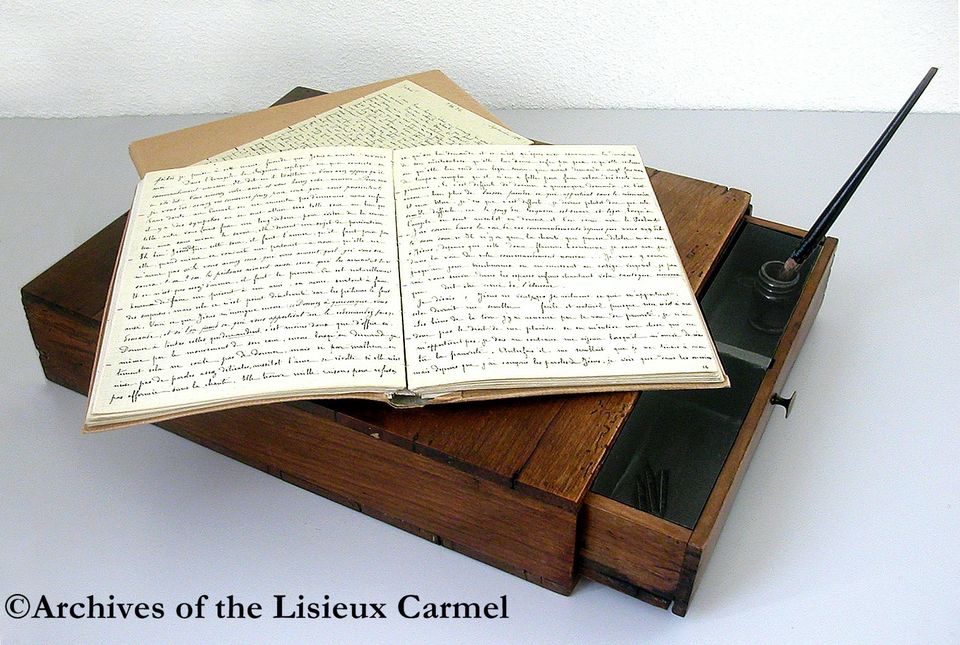 For many years, the world believed that Therese's Story of a Soul, which took the world by storm, had been published on September 30, 1898, the first anniversary of her death. In fact, it was published on October 20, 1898. The Archives of the Lisieux Carmel preserve a note by Therese's sister Celine, Sister Genevieve of the Holy Face, giving the date October 21, 1898, but Father Conrad De Meester, in his critical edition Histoire d'une Ame (Paris, Presses de la Renaissance, 2001), shows that it was received at Lisieux on October 21, but was published by Librairie St. Paul at Bar-le-Duc on October 20. The influence of Therese's published manuscripts has been so great that we must consider October 21, 1898 as a crucial date for the Christian faith.
For many years, the world believed that Therese's Story of a Soul, which took the world by storm, had been published on September 30, 1898, the first anniversary of her death. In fact, it was published on October 20, 1898. The Archives of the Lisieux Carmel preserve a note by Therese's sister Celine, Sister Genevieve of the Holy Face, giving the date October 21, 1898, but Father Conrad De Meester, in his critical edition Histoire d'une Ame (Paris, Presses de la Renaissance, 2001), shows that it was received at Lisieux on October 21, but was published by Librairie St. Paul at Bar-le-Duc on October 20. The influence of Therese's published manuscripts has been so great that we must consider October 21, 1898 as a crucial date for the Christian faith.
The splendid Web site of the Archives of the Carmel of Lisieux tells the story of the publication in its article "Story of a Soul in the making - 1897-1898 - in the details," recounting how Therese's uncle, Isidore Guerin, agreed to finance an edition of 2,000 copies and how he sought bids from several printers. There you can also read in English translation the first reactions of the readers (some of whom had known Therese) who wrote to Carmel.
We are so accustomed to having these powerful manuscripts that it's hard to imagine the world before they appeared. I have had the joy of giving them to many young persons on their confirmation and to the bereaved and those in many kinds of trial. How blessed we are that Therese wrote this story and that it has been shared with the world!
October 19, 2022: the 25th anniversary of the day St. John Paul II proclaimed St.Therese of Lisieux a Doctor of the Church
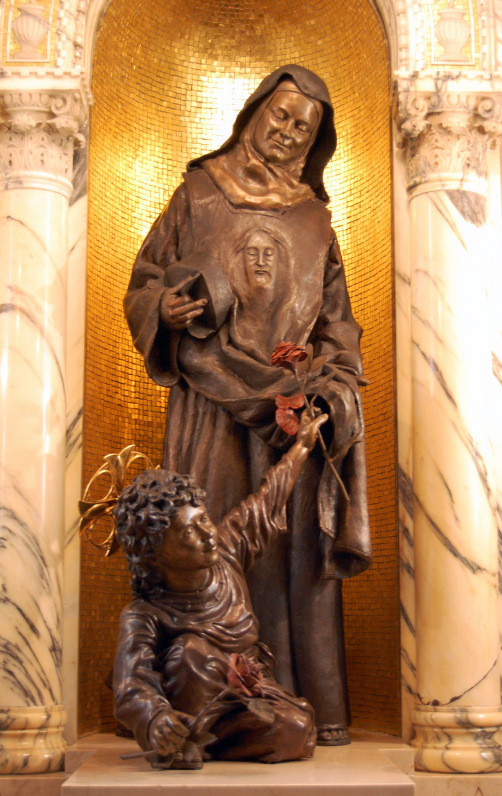 Statue of St. Therese of Lisieux as a Doctor of the Church. Courtesy of the Philadelphia Carmel.
Statue of St. Therese of Lisieux as a Doctor of the Church. Courtesy of the Philadelphia Carmel.
A quarter of a century ago, Pope St. John Paul II proclaimed St. Therese of Lisieux a Doctor of the Universal Church: the youngest Doctor and only the third woman. His reasons, and the reasons of the Church, for doing so are powerfully presented in the Apostolic Letter he issued on that occasion: Divini Amoris Scientia, the "science of the love of God." This document, his homily at the doctoral Mass, and several other documents on which one can fruitfully reflect on this occasion are gathered on my page "Doctor of the Universal Church" on "Saint Therese of Lisieux: A Gateway."
So many valuable documents and homilies were offered for that occasion that I want to reflect on what we have experienced, and what Therese has experienced, in her first 25 years as a Doctor.
- St. Therese has seen the continued travels of her relics throughout the world. This reverse pilgrimage, in which Therese comes to the people, began in 1994, and continues to this day. It has been greeted with remarkable enthusiasm, and has been an extraordinary experience of grace. Among other places, the relics were received by vast crowds in the United States in 1999, in Ireland (where 75% of the population turned out to venerate them) in 2001, and in Australia (where 400,000 people venerated them) in 2002. More remarkable than the many who came to venerate St. Therese's relics and to pray in their presence has been the atmosphere of deep prayer and the experiences of grace that accompanied them on their travels.
- St. Therese has seen her parents, Louis and Zelie Martin, beatified in 2008 and canonized, the first saints canonized as a couple, in 2015. They are a model for achieving holiness as spouses, living out the universal call to holiness of all the baptized, and becoming saints while engaged unreservedly in the life of the family, the Church, and the community.
- St. Therese has seen the opening of the cause for the beatification of her sister, Leonie Martin, Sister Francoise-Therese of the Visitation at Caen, a woman whose life shows that special-needs persons, abused and wounded persons, and those who find their true vocation only late in life can become whole and holy.
- the exposure of the clergy sex-abuse crisis all over the world;
- in much of the West, a decline in vocations to the priesthood and the religious life.
- parishes being merged or closed;
- many Christians no longer participating regularly in the life of the Church;
- the intensified persecution of Christians throughout the world
- the concentration of wealth in the hands of a few individuals, and the consequent growth of poverty in the lives of countless others
- division and polarization within and among the nations
- an increase in war and violence
For St. Therese's feast, view the film "In Search of the Little Flower: The Full Life Story of St. Therese"
To my knowledge, the film "In Search of the Little Flower: The Full Life Story of St. Therese" is the only excellent full-length documentary about St. Therese in English legally available for free viewing on the Internet. It was produced in 2019 by Sancta Familia Media (Brian Timmons and John Patrick Mallon), two devout young Catholic Scotsmen who traveled to France with their pastor, Fr. James Grant, then press secretary to the Bishops' Conference of Scotland, to make the film in order to help the people of Scotland prepare for the historic first visit of the relics of St.Therese to Scotland. From then until 2022, more than 58,000 people have viewed it online. I strongly recommend it. Feast on it!
Anniversary of Therese's offering of herself to Merciful Love on June 9, 1895
To recreate this offering on the anniversary, please visit the page "Offering of myself to Merciful Love, June 9, 1895."
"Little Flower's Body Moved from Grave to Carmel Chapel," an account of the transfer of St. Therese's body on March 26, 1923, from the "Pittsburgh Catholic"
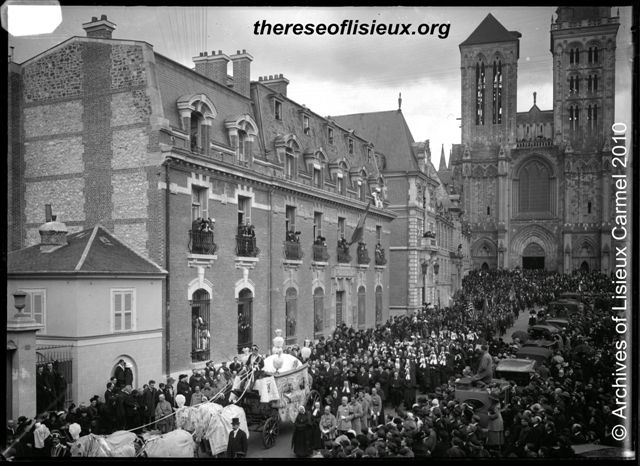 The coffin of the Venerable Therese of the Child Jesus of the Holy Face, en route f rom the town cemetery to Carmel, reaches the town square, before St. Pierre's Cathedral, March 26, 1923
The coffin of the Venerable Therese of the Child Jesus of the Holy Face, en route f rom the town cemetery to Carmel, reaches the town square, before St. Pierre's Cathedral, March 26, 1923
Paris, April 9 - The body of Sister Therese of the Infant Jesus has been taken from the cemetery of Lisieux, where it was buried in 1897, and carried to the Lisieux Chapel of the Carmel, which is to be its final resting place. The ceremony of the translation of the remains of the Little Flower was one of the most inspiring piety and, at the same time, of the most solemn grandeur.
Through the streets of the little Norman town, the coffin of the young Carmelite nun was followed by more than 30,000 people, many of them pilgrims from distant lands. In the procession were seen the khaki uniforms of three members of the American Legion, Captain Huffer and Sergeants Maire and Hum, who carried the American flag.
"It is a true prodigy," said one of the newspapers in commenting on the event, "that a frail young girl who entered the cloister at the age of 16* and died at the age of 24, after a life of isolation and humility unknown to the outside world, should be able, after her death, to inspire such a universal movement of affection and veneration."
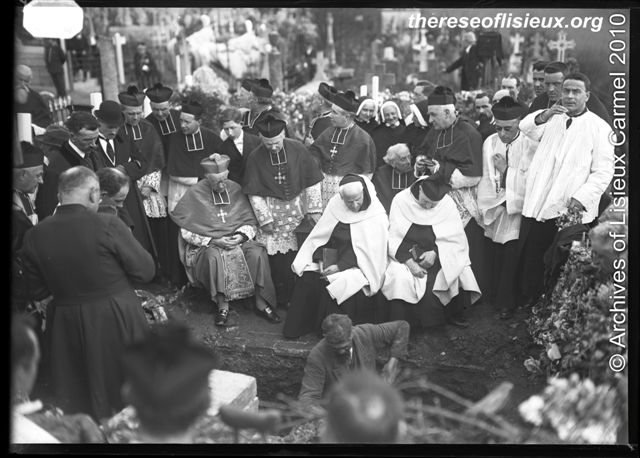 Mgr Lemonnier, bishop of Bayeux and Lisieux; Fr. Rodrigo, O.C.D., Postsulator and Delegate of the Holy See; clergy, nuns, and o thers observe as the gravediggers prepare to exhume the coffin of the Venerable Therese of the Child Jesus of the Holy Face from the earth.
Mgr Lemonnier, bishop of Bayeux and Lisieux; Fr. Rodrigo, O.C.D., Postsulator and Delegate of the Holy See; clergy, nuns, and o thers observe as the gravediggers prepare to exhume the coffin of the Venerable Therese of the Child Jesus of the Holy Face from the earth.
The body of the Little Flower was exhumed for the first time in 1917,** and buried again in the cemetery of Lisieux in a triple coffin of ebony, lead and mahogany. On the occasion of the present exhumation, the delegate of the Holy See, Rev. Father Rodrigo, the Postulator of the Cause at Rome, the Bishop of Bayeux and Lisieux, the members of the family of the young Carmelite, and the civil authorities were all present to see that the coffin was instact.
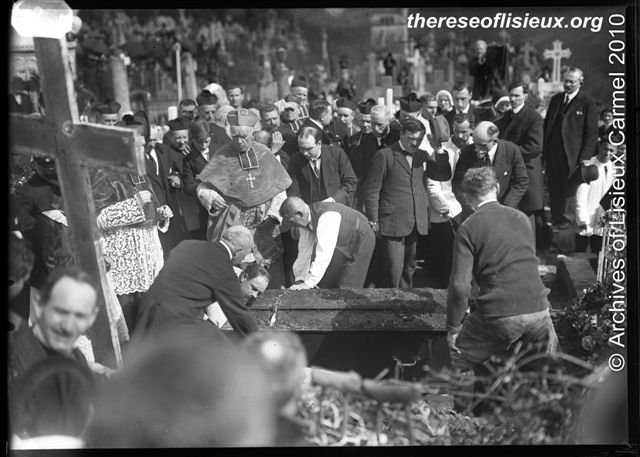 Bishop Lemonnier of Bayeux and Lisieux presides as the gravediggers remove the coffin of the Venerable Therese of the Child Jesus of the Holy Face from the earth.
Bishop Lemonnier of Bayeux and Lisieux presides as the gravediggers remove the coffin of the Venerable Therese of the Child Jesus of the Holy Face from the earth.
At the grave, which was marked by a simple cross of white wood, with black letters, Bishop Lemmonier received the depositions demanded by the Church. The caretaker of the cemetery, who has occupied his post for 20 years, and the sacristan of the Carmel both made oath on the Gospels that they recognized the grave and that they had been present at the various burials and exhumations. Then, when the grave had been opened and the coffin raised, Father Rodrigo observed that the seals placed over the screws of the lid in 1917 were intact.
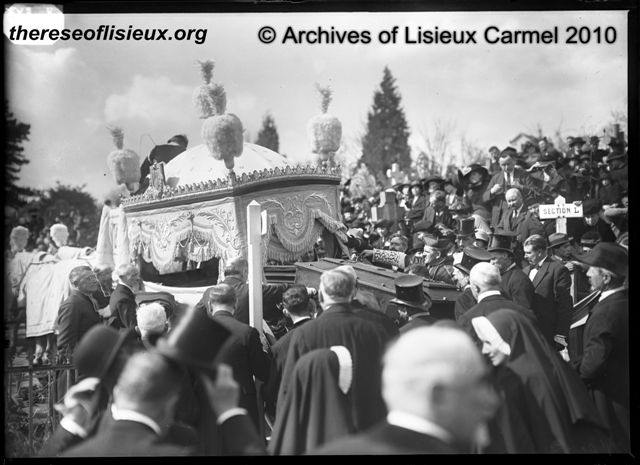 St. Therese's coffin is transferred to the carriage whch will carry it to her Carmel, March 26, 1923
St. Therese's coffin is transferred to the carriage whch will carry it to her Carmel, March 26, 1923
The coffin was then placed on a white hearse drawn by four white horses richly caparisoned with trappings of the same color. On the right and left sides of the hearse were two panels containing portraits of the Little Flower, as traditions [sic] represents her, smiling with infinite sweetness. The coffin was covered with a magnificent cloth of gold, richly embroidered especially for the ceremony.
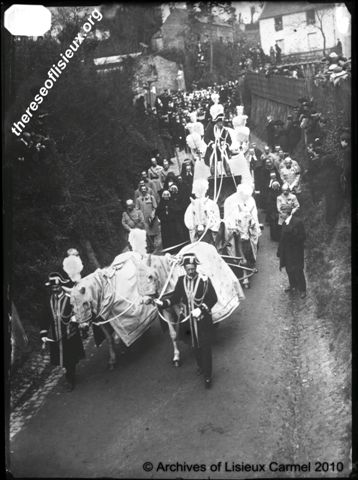 The procession of the coffin of St. Therese travels down the cemetery hill toward the Carmel of Lisieux, March 26, 1923
The procession of the coffin of St. Therese travels down the cemetery hill toward the Carmel of Lisieux, March 26, 1923
The procession moved slowly down the hill from the cemetery to the town, and all along the way the roadsides were lined with men and women who made the sign of the cross while tears of gratitude or hope filled their eyes.
At the four corners of the hearse walked four Carmelite nuns with lowered veils. To the right and left marched a double line of officers, non-commissioned officers and private soldiers, in uniform; all veterans of the late war, who had been cured or protected and who had come to thank the Little Flower for having interceded for them. The lines were headed by a Colonel and several battalion commanders.
Behind the hearse came members of the families related to the Little Flower, and three outdoor sisters*** from the Visitation Convent of Caen, where one of the sisters of the young Carmelite still lives. Next came delegations from the Catholic schools, clubs, and societies, and a crowd of faithful, making a line several kilometers long.
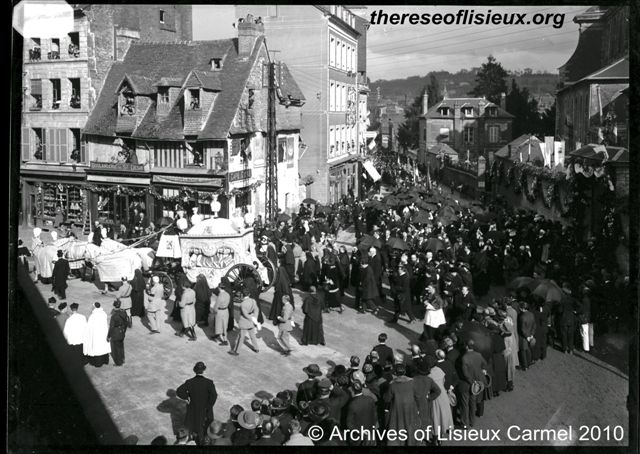 Thousands line the streets of Lisieux as the body of St. Therese, followed by many thousands, returns to the Carmel chapel, March 26, 1923. The crowd of pilgrims was estimated at between 30,000 and 50,000. After reaching the city, the procession moved very slowly through the streets, which were splendidly decorated with garlands, flags, trees, and triumphal arches. People from distant parts of the country waited for hours on the sidewalks, and the sloping roofs of the old Norman houses were lined with those who had come to witness the passing of "Little Sister Therese." As the procession passed, the demeanor of the crown [sic] was of touching respect. Not a word was heard; there was no pushing or craning; nothing but the motion of thousands of hands making the sign of the cross.
Thousands line the streets of Lisieux as the body of St. Therese, followed by many thousands, returns to the Carmel chapel, March 26, 1923. The crowd of pilgrims was estimated at between 30,000 and 50,000. After reaching the city, the procession moved very slowly through the streets, which were splendidly decorated with garlands, flags, trees, and triumphal arches. People from distant parts of the country waited for hours on the sidewalks, and the sloping roofs of the old Norman houses were lined with those who had come to witness the passing of "Little Sister Therese." As the procession passed, the demeanor of the crown [sic] was of touching respect. Not a word was heard; there was no pushing or craning; nothing but the motion of thousands of hands making the sign of the cross.
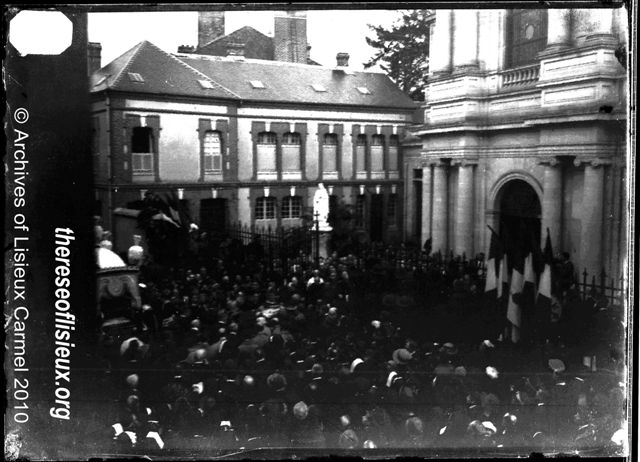
In front of the Carmelite chapel, the hearse stopped at last, and the coffin was borne into the illuminated choir, while a group of singers sang the hymn of Virgins to the accompaniment of a Handel choral, played on the new organ of the chapel which was used for the first time.
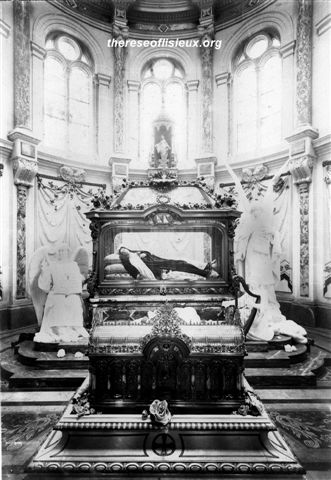 The reliquary of St. Therese at the Carmel of Lisieux
The reliquary of St. Therese at the Carmel of Lisieux
On the following day, the official recognition of the remains took place in the presence of two delegates of the Supreme Pontiff and two physicians.
NOTE: This contemporaneous account appeared in the Pittsburgh Catholic in April 1923, probably in the issue dated April 19, 1923
Editor's notes:
* This is a mistake; Therese was 15 when she entered.
**The first exhumation took place in 1910, the second in 1917.
*** "Outdoor" here is probably a translation of "extern sister," that is, a member of a cloistered religious community who is not enclosed and is responsible for receiving visitors, doing necessary errands, and otherwise serving as a liaison between the community and the world.
The photos with which this article is illustrated did not appear in the 1923 article in the Pittsburgh Catholic. They appear here thanks to the kindness of the Archives of the Carmel of Lisieux.
For an even more detailed account of the day, from the Archives of the Carmel of Lisieux, please visit "The Solemn Translation of St. Therese's Relics from the Town Cemetery to the Carmel of Lisieux, March 26, 1923."